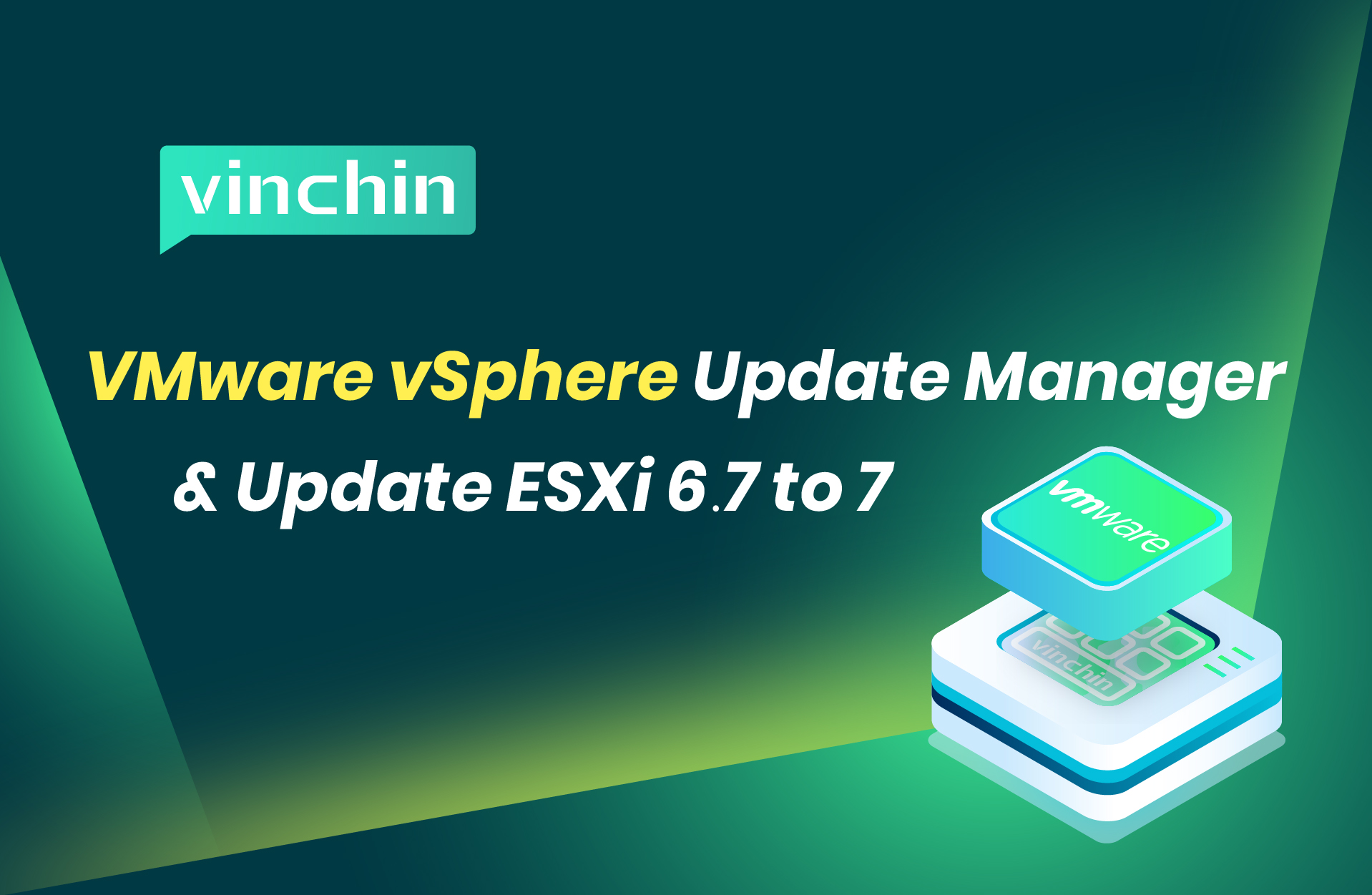-
Upgrade ESXi 6.7 to 7.0 with vSphere Lifecycle Manager
-
Upgrade ESXi 6.7 to 7.0 with ESXCLI
-
Conclusion

Updating ESXi patches helps get rid of security loopholes that hackers could exploit, which could be installed through the ESXCLI command line set. But patch installation via ESXCIL commands is time-consuming and increasingly complicated with the different versions of ESXi. Or you can use the official lifecycle management tool vSphere Update Manager to keep multiple ESXi hosts up to date. Then, you might Google “What is VMware vShphere Update Manager?”
Here it is. VMware vShpere Update Manager (VUM) is a vCenter extension that allows for centralized, automated patch and version management for VMware vSphere and provides support for VM and hosts running the VMware ESXi OS.
The plug-in is installed manually on vCenter Server versions earlier than vCenter 6.5 (including vCenter 6.5 on Windows) and pre-installed automatically in version 6.5 or higher. Due to its close integration with vCenter Server, VUM requires network access to the latter. VMware provides an alternative solution to this tool since vSphere 7, vSphere Lifecycle Manager.
VUM is used to:
Install and upgrade ESXi hosts' drivers, VMware Tools, and third-party software.
Upgrade VM hardware.
Multi-entity updates and upgrades are made with VUM.
Check cluster compliance.
Patch ESXi hosts.
Prerequisites:
Requirements:
A 2GHz processor with two logical cores.
2GB RAM for VUM on a different computer from the vCenter Server, and 8 for the same computer.
Enough VUM database disk space.
Do not install VUM on a Microsoft directory domain controller.
Supported DB: VUM needs a SQL database for its operations, which can be either an Oracle or a Microsoft database. You can use the VMware Interoperability Matrix to match the compatible versions.
Supported OS:
| Windows OS (Microsoft Windows Server) | 6.7 U3 | 6.7 U2 | 6.7 U1 | 6.7 | 6.5 U3 | 6.5 U2 | 6.5 U1 | 6.5 | 6.0 U3 | 6.0 U2 | 6.0 U1 | 6.0 |
| 2016 64-bit | ✔ | ✔ | ✔ | ✔ | ✔ | ✔ | ✔ | ✔ | ||||
| 2012 R2 64-bit | ✔ | ✔ | ✔ | ✔ | ✔ | ✔ | ✔ | ✔ | ✔ | ✔ | ✔ | ✔ |
| 2012 64-bit | ✔ | ✔ | ✔ | ✔ | ✔ | ✔ | ✔ | ✔ | ✔ | ✔ | ✔ | ✔ |
| 2008 Service Pack 2 64-bit | ✔ | ✔ | ||||||||||
| 2008 R2 Service Pack 1 64-bit | ✔ | ✔ | ✔ | ✔ | ✔ | ✔ | ✔ | ✔ | ✔ | ✔ | ✔ | ✔ |
| 2008 R2 64-bit | ✔ | ✔ | ✔ | ✔ | ✔ | ✔ | ✔ | ✔ | ✔ | ✔ | ✔ | ✔ |
Before updating process:
Check the compatibility versions between:
Existing vCenter and the new ESXi; present ESXi and the upgrade; backup software and new vCenter and ESXi; hardware and ESXi patches.
The server hardware must meet the requirements of ESXi 7.0.
No running VMs on ESXi hosts.
Enough storage for the upgrade.
Upgrade the vCenter version to 7.0 to manage ESXi 6.5, 6.7, and 7.0.
Save ESXi configurations and backups in advance for rollback.
Supporting both ESXi 6.x and ESXi 7.0 versions, Vinchin Backup & Recovery continues to help VMware users back up and restore VMs after the upgrade. It also delivers features as follows:
Automated backup: create worry-free backups periodically and automatically with schedules and email notifications.
Cross-platform V2V migration: migrate VMware to other 10+ hosts or vice versa without agents or tools in 4 steps.
Instant recovery: bring the corrupted VM back in 15s from the backup repository or an offsite backup copy saved in another Vinchin center for business continuity.
60-day free trial: a full-featured free trial is available below for exploration (CBT, HotAdd, 50% data reduction, and more).
Upgrade ESXi 6.7 to 7.0 with vSphere Lifecycle Manager
1. Start vSphere Lifecycle Manager in vSphere Client by clicking Home> Lifecycle Manager or Menu at the top of client> Lifecycle Manager.
2. Go to Imported ISOs tab> IMPORT ISO> Browse for installation ISO image file.
3. Click New baseline> enter Name and Description> Update> Select ISO> Summary.
4. In the Hosts and clusters screen, choose the ESXi host to be updated and click Updates from the ... tab next to the Datastores.
5. Hit Baselines> in the Attached Baselines section, under ATTACH dropdown list, find Attach Baseline or Baseline Group, then attach the baseline created and click Attach.
6. Click CHECK COMPLIANCE to see if the ESXi host had attached an update already, non-compliant status means you can install the update.
7. Click PRE-CHECK REMEDIATION to check for compliance after the upgrade.
8. In the Attached Baselines page, choose the baseline created and click Remediate.
9. Check I accept the terms and license agreement and click OK.
10. Click REMEDIATE to upgrade.
Note: the upgraded VM should be powered off or migrated from the host.
11. Apply for ESXi 7.0 licenses from My VMware and assign them to upgraded hosts if the license is expired.
Upgrade ESXi 6.7 to 7.0 with ESXCLI
1. Enable ESXi Shell and SSH:
A. Permanent way: In the ESXi direct console> System customization> Troubleshooting options> Enable ESXi Shell and Enable SSH.
B. Input ESXi host IP address in a browser> log in to VMware Host Client> Manager> Services> Start TSM and TSM-SSH (enabled after reboot). Navigate to Help in the client to check the ESXi version> About.
2. Turn off VMs on the ESXi.
3. There is an offline and online method respectively.
Offline:
1. Download the offline bundle from the VMware website.
2. In the VMware ESXi web client, right-click Manage on the left pane and choose Enter maintenance mode.
3. Go to Storage> Datastore> Datastore browser > select a directory for the bundled files > Upload the download Zip file to the datastore.
4. Run the commands to upgrade:
esxcli software profile update -p ESXi profile name -d /vmfs/volumes/datastore/ESXi7-bundle/ZIP file.zip
5. Reboot the ESXi host and assign a serial number for ESXi 7.0.
Online:
1. List the present image file and packages.
esxcli software profile get
2. Put ESXi into maintenance mode (choose one).
vim-cmd /hostsvc/maintenance_mode_enter
esxcli system maintenanceMode set --enable true
3. Allow HTTP traffic.
esxcli network firewall ruleset set -e true -r httpClient
4. List ESXi 7.0 update profiles.
esxcli software sources profile list -d https://hostupdate.vmware.com/software/VUM/PRODUCTION/main/vmw-depot-index.xml | grep ESXi-7.0U2
5. Check packages installed.
esxcli software profile update -d https://hostupdate.vmware.com/software/VUM/PRODUCTION/main/vmw-depot-index.xml -p ESXi-7.0U2d-18538814-standard --dry-run
6. Update.
esxcli software profile update -d https://hostupdate.vmware.com/software/VUM/PRODUCTION/main/vmw-depot-index.xml -p ESXi-7.0U2d-18538814-standard
7. Select esxcli software profile update.
Note: determine if there is a persistent scratch partition for the “Got no data from process” error.
8. Reboot the ESXi host.
Reboot
9. Exit maintenance mode (choose one).
vim-cmd /hostsvc/maintenance_mode_enter
esxcli system maintenanceMode set --enable false
Conclusion
vSphere Update Manager is the VMware upgrade and patch tool, and since vSphere 7, vSphere Lifecycle Manager is available for more comprehensive lifecycle management. You can use them to upgrade ESXi versions. But either way, VMware backup is necessary before upgrading or any risky operations in case of errors and disasters.
Share on:









